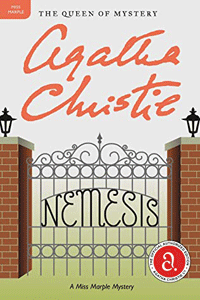Agatha Christie might’ve seemed like she was losing her marbles on the spy thriller “Passenger to Frankfurt” (1970), her worst novel to this point. But at least she doesn’t lose her marbles on a Marple: The author bounces back with “Nemesis” (1971).
This one is solvable
The penultimate Miss Marple novel delivers a solvable mystery; I can’t say I guessed whodunit but I did spot all the relevant clues and generally knew how they’d fit together. Another notable trait of this book: Christie strives to give a definitive portrait of Marple, starting with how Mr. Jason Rafiel sees her. Marple may be a pleasant old woman, but her dominant trait is her sense of justice. She won’t hesitate to see a murderer found out and captured.
Indeed, Rafiel – a vacationing financier who collaborated with Marple to stop a killer in “A Caribbean Mystery” (1964) — now turns to Marple for his most important and final mission. Rafiel passes away, but through his lawyers he hires Marple to clear his imprisoned son, Michael, of a murder from 10 years ago.

“Nemesis” (1971)
Author: Agatha Christie
Genre: Mystery
Series: Miss Marple No. 12
Setting: Jocelyn St. Mary, England, 1971
Although Christie is back on track compared to “Frankfurt,” “Nemesis” is relatively weak as Marples go. It’s easily readable, but it takes an awfully long time – about 100 pages out of 271 – for Marple to even know what case she is working on.
Rafiel has simply put her in the right spot – a bus tour of churches and gardens will include a stop in the village of Jocelyn St. Mary – to find out who really killed Michael’s girlfriend Verity. Rafiel has instructed three sisters, of whom Verity had been like a daughter, to invite Marple to stay with them during this layover. The idea is that Marple will do her thing, the same way cops put a bloodhound on a trail.
Not 13 problems, but at least a few (Spoilers)
A problem with “Nemesis” is that it’s so insistent on being mysterious. (SPOILERS FOLLOW.) Retired school headmistress Elizabeth Temple tells Marple that Verity (her former student) died because of “love.” Conveniently for the sake of the continuing slow burn, Temple is soon murdered.
I don’t know what a more in-depth conversation between Marple and Temple would’ve looked like. Presumably Temple did not flat-out know Clotilde killed Verity out of a jealous love, or she would’ve told the cops. I guess the idea is that Temple had a vague sense of love playing a part in the death. This is similar to how Marple senses evil in Jocelyn St. Mary. Her sixth sense has grown stronger with age; it’s even more well-honed than Poirot’s sense of evil in “Evil Under the Sun.”

Less forgivable than Temple’s clue that comes from “a sense” is the presence of the two undercover detectives, Miss Cooke and Miss Barton. I can’t think of any reason why they can’t tell Marple their identities beforehand.
If Rafiel (via his lawyers) had gathered Cooke, Barton, Marple and the other amateur investigator, Professor Wanstead, together beforehand so they know they are a team, it would not have hampered the investigation. Rafiel may be somewhat playful, but it’s odd that he’d play around with his son’s fate on the line.
Another note of criticism: Clotilde falsely identifies Nora’s facially disfigured body as Verity’s. Christie mentions a mole or a scar as possible identifying marks (although she forgets about this in the “Miss Marple Tells Her Story” chapter that gives the end of “Psycho” a run for its money). Why and how is Clotilde’s (fabricated) ID good enough for the police? In the 1970s, shouldn’t IDs of corpses be more thorough and scientific?
(END OF SPOILERS.)
Good points
There are fun points about “Nemesis.” It’s one of the few Christie novels where you definitely need to read a previous one (“A Caribbean Mystery”) beforehand. Another duology like this is “The Secret of Chimneys” and “The Seven Dials Mystery” from the Twenties. And the five Tommy & Tuppence books should be read in order because they show the couple’s progress through life.
“Nemesis” mildly has a place in time, as Christie examines Michael’s traits (he’s not a murderer, but he’s still imperfect). Rape is treated more casually here than in present day. And it’s remarkable that such a thing is mentioned at all.
We also see a change in euphemisms for pregnancies out of wedlock: “She got in trouble” has become “She’s in a family way.” The novel is about a half-step away from bringing up abortion, but it doesn’t go there.
It’s impressive how Jason Rafiel is a vibrant presence even though the book starts with his obituary. Christie strives to make the Marple-Rafiel team more substantial than it really is, and to make Marple’s status as “Codename Nemesis” more serious than it really is. These aspects are worthy of a smile, though.
Dark Marple
One of the hosts of the podcast All About Agatha likes to mention his “Dark Marple” theory, which holds that Marple is always acting nice and fluffy but in actuality she relishes being around murders and bringing killers to justice. (A less serious version of the theory has her actually being a murderer and framer of innocent people, thus explaining how a non-professional detective has so many corpses pile up around her.)
There’s some truth to that. Indeed, Marple’s acting skills are on full display in “Nemesis’ ” scene at the post office, where she slyly gets information she needs from the clerk. But I don’t think there’s a buried reading of Marple’s behavior that’s darker and grimmer than what’s on the surface.
In “Nemesis,” Christie is up front with who Marple is. The author deliberately impresses the elderly sleuth’s traits on us, in wordy fashion. She’s less up front with Rafiel’s overarching plan, and that’s fair in some ways, contrived in others. The second-to-last Marple is enjoyable, but too clunky to be elite.
Sleuthing Sunday reviews an Agatha Christie book or adaptation. Click here to visit our Agatha Christie Zone.

